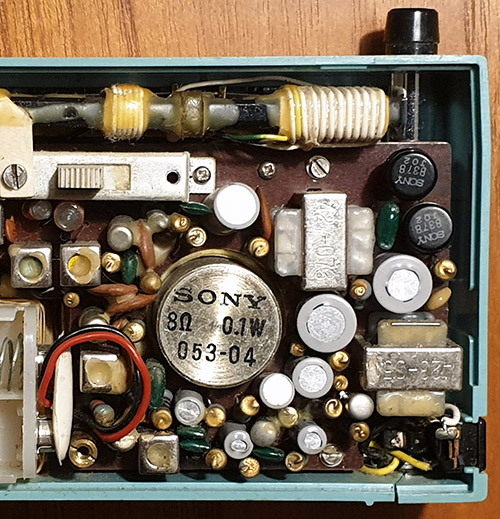The ware for June 2023 is shown below.

This ware should be possible to match to an exact model number, based on this photo alone — if not simply because in its era there were fewer consumer electronics devices to choose from.
I tested the image against Google Image search and this particular crop of the ware seems to foil any exact matches. However, if you do manage to find an exact hit with a simple image search engine query, I’d be curious to know what you’re using, so I can use this to test against future wares.
According to the original owner, this ware cost almost a month’s wages back when it was purchased!
well it’s obviously some kind of toaster oven
Well, I would say a Sony transistor radio, TR-729?
No need to search for image, actually. Very obvious what it is from the parts, and the era where it is from. Brand, as well, since no other manufacturer would use a Sony speaker except Sony itself. The TR range from Sony is very well documented.
This screamed transistor radio to me for some reason (the loudspeaker in the middle, the antenna port top right and the ferrite tuning circuit below, the twin AA battery compartment). After some browsing on various vintage Japanese radio websites (great spend of time by the way), came across a picture of a Sony TR-729 (https://www.japanradiomuseum.com/tr-radio-e#SONY%20TR-729) which looks nearly identical.
So much lost art in there…
I wouldn’t say it was lost. A lot of us learned our electronics from understanding radios and other devices of this vintage. I would say they had a long influence on a lot of later designs.
A lot of radios were 6 transistor. This one was 7. What was the extra transistor for?
Marketing, probably. Including an extra tube or transistor with minimal/no functionality was invented about 30 seconds after someone built the first tube radio.
I recognized this as some sort of transistor radio right away, without knowing specifically which one. It reminds me of the things I used to take apart as a kid in the late 70’s, early 80’s. Huge dose of nostalgia. Thanks, Bunnie!
I can see 2 of 2SB378 transistors in the push-pull transformer coupled audio power output stage.
https://www.radiomuseum.org/tubes/tube_2sb378.html links to
https://www.radiomuseum.org/r/sony_tr_1000tr100.html “Sony TR-1000 portable transistor 4 band AM radio”. It has a button on the top, but the case looks larger than in Bunnies’ image.
The Sony TR-729 is a better visual fit – https://www.radiomuseum.org/r/sony_tr_729.html
but it lists 2SD65 rather than 2SB378. This could be an error.
HTH, Glenn
Search by image leaves much to be desired when it comes to finding an exact match. It still takes an enthusiast with a keen eye to correctly identify a legacy electronic device.
If it’s a TR-729 then it’s as old as I am. :)
Ah, yes, memory material.
My mother had a similar one, not Sony, but same size and color, and she would carry it everywhere to listen to baseball games. You could be at somebody’s wedding and mom would have the radio if it was an important game.
I always thought the wax was cheesy, but now I think it is quite smart. it gives vibration damping, some moisture proofing, locks the tuning coils and prevents slight movements of the RF parts which might detune sensitive circuits. I still don’t get how they formulate it so it doesn’t just melt and run out on hot days.
These Japanese transistor radios were an early source of transistors for projects and experiments, but I went to silicon ones as soon as I could.